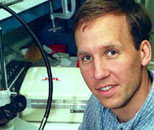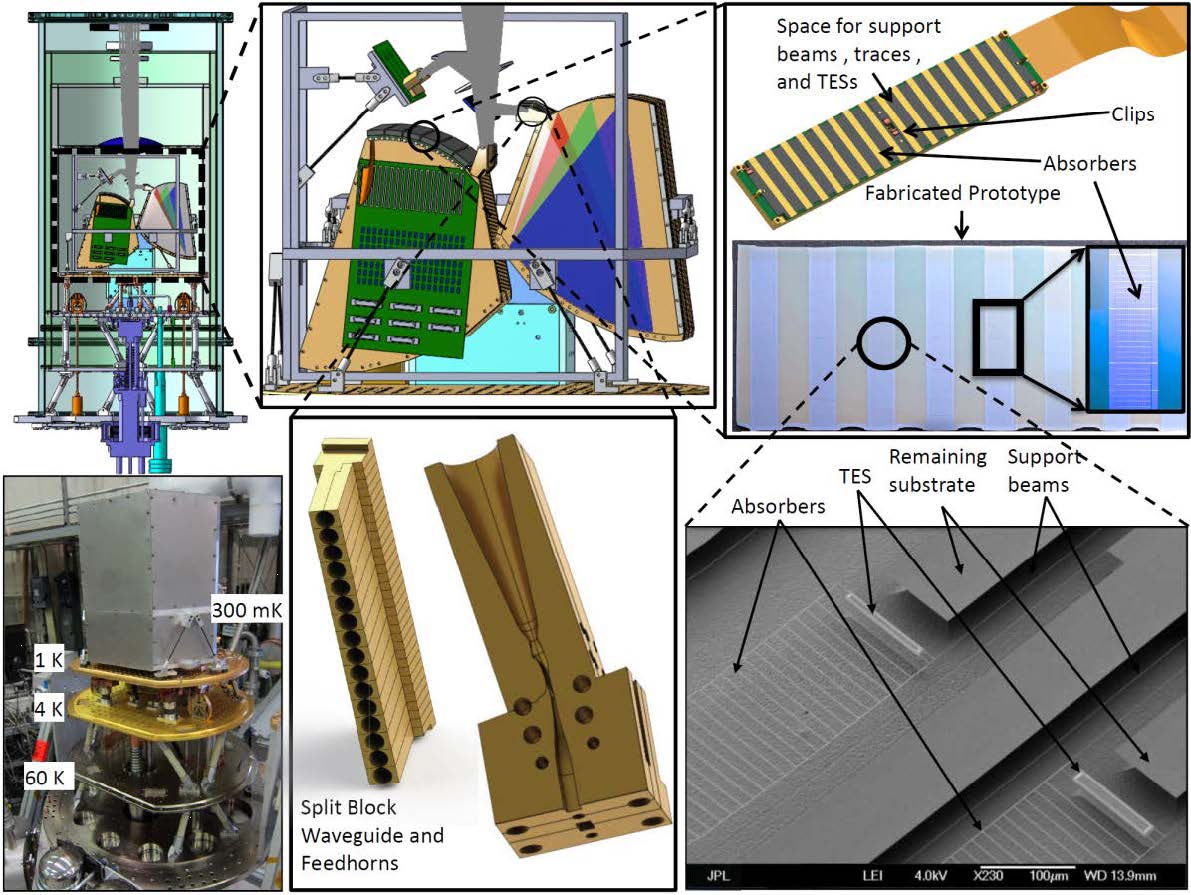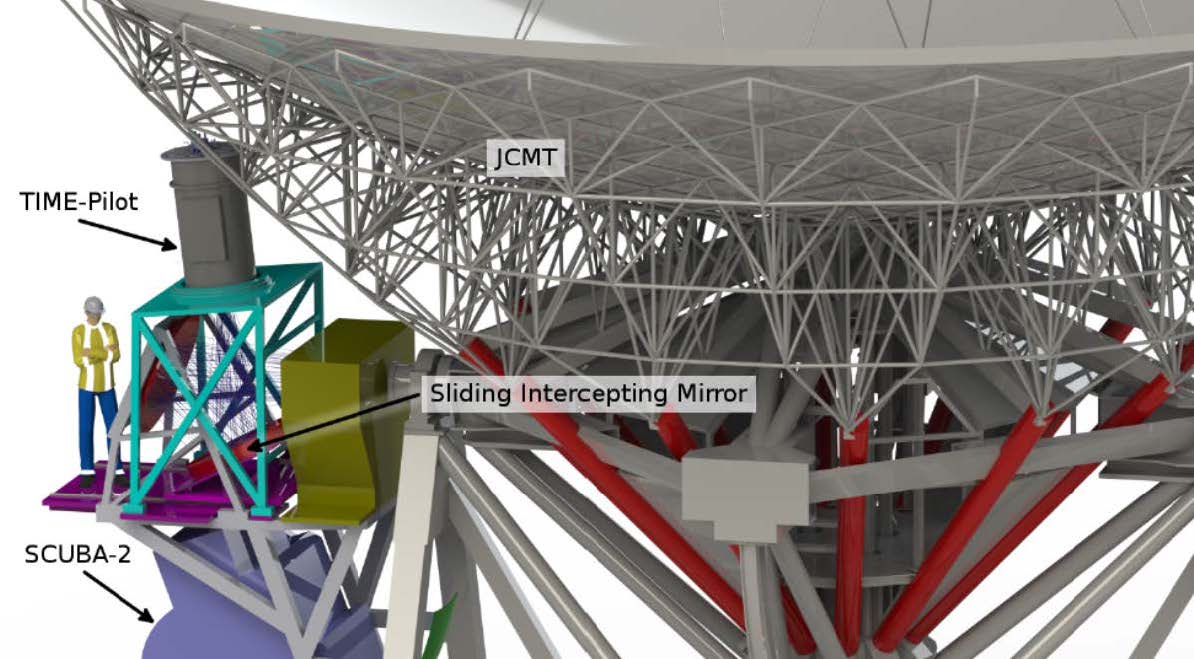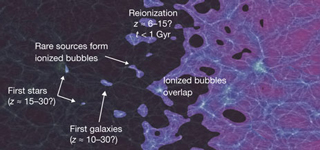Technical Development - Completed March 2016
Mapping the Epoch of Reionization with C+ Line Tomography
Final Report
James J. Bock (Caltech)
Campus PI

Charles M. Bradford (JPL)
JPL PI
Project Participants:
- James Bock, Caltech
- Charles Bradford, JPL
- Tzu-Ching Chang, ASIAA
- Asantha Cooray, UC Irvine
- Abigail Crites, KISS Prize Postdoc, recently awarded NSF postdoctoral fellowship
- Olivier Doré, JPL
- Steve Hailey-Dunsheath, Caltech
- Jonathon Hunacek, Caltech graduate student, awarded NSF graduate fellowship
- Chao-Te Li, ASIAA
- Mario Santos, IST-Centra
- Phillip Lubin, UCSB
- Hien Nguyen, JPL
- Roger O’Brient, Caltech postdoc, hired as JPL technologist
- Erik Shirokoff, KISS Prize Postdoc, hired as assistant professor at U. Chicago
- Zachary Staniszewksi, Caltech postdoc, hired as JPL systems engineer
- Bade Uzgil, U. Pennsylvania graduate student, hired as postdoc at UC Irvine
Description
Our KISS program has laid the theoretical foundations for probing the epoch of reionization with C+ tomography measurements, developed unique lithographed millimeter-wave spectrometer technology, and initiated a first-light C+ experiment named TIME-Pilot. With KISS support we have carried out the following investigations:
- Developed the case for line intensity mapping methods to study the epoch of reionization using singly ionized carbon (C+), typically the most luminous emission line in galaxies. The theoretical studies not only explored the amplitude of the signal, and the usefulness in determining physical properties of the partially ionized intergalactic medium, but also the effects of foreground confusion from low-redshift galaxies. Our team made the first calculations of C+ clustering fluctuations from the reionization epoch, and estimated the effect of foreground galaxy confusion, largely from CO line emission at z ~ 1. We also authored the first papers on tomographic measurements with the Lyα emission line, which shows great promise for near-infrared intensity mapping measurements with the SPHEREx SMEX mission concept.
- Developed a complete design for a first-detection instrument of [CII] large-scale clustering emission named TIME-Pilot, based on an array of 32 novel waveguide spectrometers. The spectrometers are mounted in a linear array in two polarizations, and observations are carried out by scanning the detectors in a 1-deg linear strip, which maximizes depth (small survey area) while preserving sensitivity on large scales (long scan length).
- Demonstrated the key waveguide spectrometer technology, which confines radiation in 2 dimensions and the power propagates between parallel plates and is dispersed and collimated by a curved grating. The waveguide spectrometers greatly reduce the mass and volume that would otherwise be required with a conventional 3-d grating spectrometer.
- Demonstrated a prototype superconducting detector array. These high-sensitivity superconducting bolometers are mounted on the focal surface across multiple spectrometers, and read out by superconducting current amplifiers. The devices present unique micro-machining challenges to produce edge-butted sub-arrays that do not leave spectral gaps between channels.
- Completed the full cryogenic system for the instrument. We commandeered an existing 4 K cryostat from another project, and added cooling stages to an ultimate temperature of 220 mK to meet the TIME-Pilot cooling requirements. The system is fully tested and operational.
- Formed a partnership with ASIAA in Taiwan, led by Tzu-Ching Chang who attended the original KISS study. ASIAA is providing major hardware components for the TIME-Pilot instrument, and in the past year have developed a prototype of the spectrometer, and procured cables and cryogenic coolers. ASIAA has also become the managing institution for the James Clerk Maxwell Telescope (JCMT) in Hawaii, and ideal facility for carrying out observations with the instrument.

Figure 1. TIME-Pilot instrument overview and heritage. The instrument will be housed in an existing closed-cycle 4 K / 1 K / 300mK cryostat (bottom left), with an enlarged cryogenic volume to allow insertion of the spectrometer stacks and optics (top left). The 32 waveguide grating spectrometers (top center) are assembled into two stacks of 16, they couple the same 1-D linear field on the sky via an array of feedhorns and polarized waveguide (bottom center) looking off a polarizing grid. Each grating spectrometer is similar to that used in Z-Spec, but they are smaller and simpler for TIME-Pilot since they operate at lower resolving power (R=150, vs. R=300 for Z-Spec). The dispersed light is detected with twelve 2-D arrays of TES bolometers which span the spectrometer stacks (right) with a total of 1840 detectors. The TESes (lower right) are similar to those built at JPL for CMB polarimetry as well as demanding space-borne spectroscopy. Sixteen 150 GHz broadband channels view the same sky as the spectrometers via a dichroic filter, and will be used in surveys of the kSZ effect in galaxy clusters.

Figure 2. TIME-Pilot installed at the JCMT. The TIME-Pilot cryostat mounts above the platform that holds the current SCUBA-2 instrument and mirror. By adding one extra mirror, we intercept the beam headed toward SCUBA-2 and direct it upward to our instrument. The intercepting mirror will be on a platform that can slide the mirror away for quick switching back to normal SCUBA-2 observing. Figure
